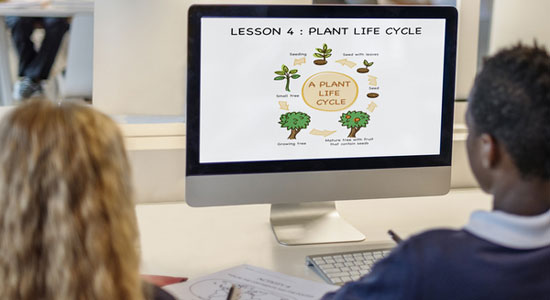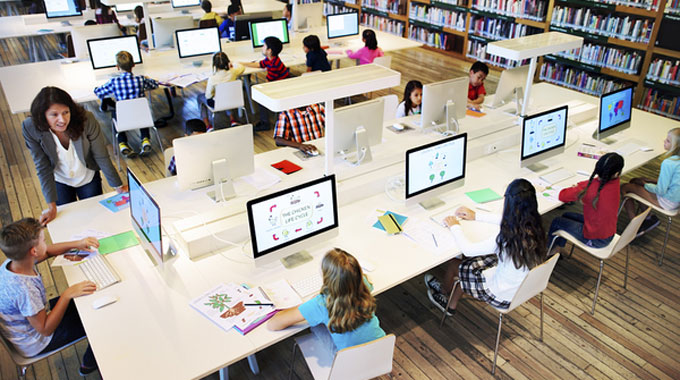
Using Nearpod to Support Blended and Flipped Learning
Introduction
As technology is being used to support student learning in more and more classrooms, blended and flipped learning implementations have become more common. While there are distinctions between these two types of learning environments, central to both is the idea of student-centered learning.
As defined by the 2017 National Education Technology Plan, blended learning:
“Allows students to have some control over time, place, path, or pace of learning. In many blended learning models, students spend some of their face-to-face time with the teacher in a large group, some face-to-face time with a teacher or tutor in a small group, and some time learning with and from peers.”
Similarly, the Nearpod team defines a flipped class as:
“One where the student first reviews the topic by himself (at home or at school), typically using video lessons or some sort of digital learning support, and then classroom time is used to apply the knowledge by solving specific problems and/or doing practical work. The flipped class thus transitions the role of the educator from a “lecturer” to a “tutor” who coaches a student when he/she gets stuck, rather than delivering a traditional one-way lecture.”
At the core of both of these ideas, is the belief that students should be more in control of their own learning processes, and that learning should be differentiated to individual student needs. Research suggests that shifting to more student-centered learning approaches like these can help increase student engagement, achievement, and agency.
Fortunately, tools like Nearpod are perfect for supporting these types of implementations in K-12 classrooms.
Facilitating Differentiation with Blended and Flipped Learning
In addition to helping increase student engagement, achievement, and agency, flipped and blended learning approaches can also be used to increased differentiation. For example, the most recent 2017 Digital Learning report from Blackboard and Speak Up found that:
“Teachers in blended learning classrooms are setting a new bar for transforming learning using technology. For example, 68% report that with the use of technology in their classroom they are better able to differentiate instruction for their students.”
Similarly, the 2015 Report on Blended Learning from iNACOL describes how blended learning approaches allow “Educators [to] quickly identify gaps in learning and differentiate instruction to ensure that failure is not an option.”
In short, flipped and blended learning approaches have to potential to help teachers increase differentiation, which in turn can lead to increased engagement and student achievement.
Using Nearpod to Support Flipped and Blended Learning
While switching to more student-centered approaches like blended and flipped learning may be beneficial for students, it can often be a difficult shift to make.
Fortunately, Nearpod makes this transition easier by providing a platform that allows content to be delivered in ways that can be differentiated, while still providing teachers with the feedback they need to understand how students are interacting with that content.
For example, Nearpod allows teachers to share “student-paced” lessons, which means each individual student can move through lesson content at their own pace, either in or out of the classroom. Students can also go back through these lessons at any time to review content or find resources, which is perfect for both blended and flipped learning environments.
Teachers can even create a wide variety of pre-built lessons and give students choices as to which they will explore. Approaches like this can help increase differentiation and give students more agency in their own learning process.
Additionally, teachers can embed formative assessments within their lessons like polls, quizzes, open-ended questions, and drawn responses. This way, even if students are working through lesson content at their own pace and on their own time, teachers can still get an accurate picture of each student’s understanding of the content.
Plus, students can also use Nearpod to create their own presentations demonstrating their understanding of what they’ve learned during their exploration of their teacher’s lessons.
Pulling all of these ideas together, the Nearpod team describes how N. Miguel, an Apple Distinguished Educator from Portugal, uses Nearpod to flip his classroom and create a rigorous, engaging, and student-centered learning environment:
“N. Miguel’s approach consists of having his students take the role of the instructor and deliver an interactive lesson using Nearpod. He first poses a ”challenge” to his students, in which they are asked to design and create an interactive lecture about a specific topic. To address that challenge, his students not only need to research the topic before class, but they also need to create a presentation using multimedia content. Students also need to create classroom activities, plan for questions and quizzes, and define learning milestones. When class time comes, students are asked to deliver their interactive lesson to the rest of the class using Nearpod.”
Conclusion
Overall, creating blended and flipped learning environments can help teachers increase differentiation and shift towards more student-centered practices. In turn, this can help lead towards increased student engagement, achievement, and agency – meaning that students will feel more in control of their own learning.
By using Nearpod to facilitate this type of learning, teachers can create lessons where students work through the material on their own time, both in and outside the classroom. Plus, teachers can embed formative assessments into these lessons, so they always know exactly what their students have mastered, and where struggles still exist.
Ready to give Nearpod a try to start blending or flipping your own classroom? Click here to get started and create a lesson now!

Nearpod’s award-winning platform is used by thousands of schools around the globe, transforming classroom engagement.









